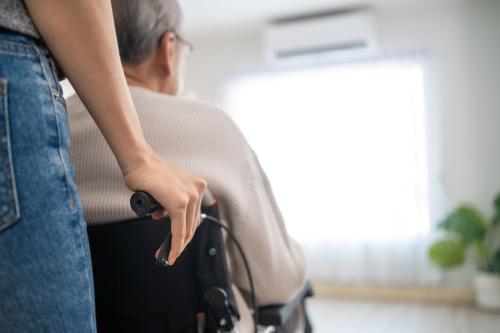Introduction and overview
The population that needs long-term services and supports (LTSS) to live successfully in their home community is diverse, and often has a complicated set of functional impairments that necessitates care from both non-medical and medical services. Individuals with a serious mental illness (SMI) that persistently interferes with their ability to function in daily life and low income who qualify for Medicaid may be eligible for services and supports available in their home communities that are known as home and community-based services (HCBS). Yet with Medicaid, a joint federal and state program, few states choose to deliver such care to this population through their Medicaid HCBS programs. Given the continued emphasis towards community living and individual autonomy for those ages 65 and older (the population we call older adults) and people with mental illnesses, we consider whether there are missed policy opportunities in Medicaid to provide a richer array of supports to older adults with mental illness. This question is particularly salient, given that failures to access necessary care have the potential to lead to neglect, institutionalization, and suicide in older adults.
A larger segment of the population that uses LTSS experiences functional impairments that are due to causes other than mental illness. However, functional impairments from physical conditions such as immobility, deafness, and visual impairments are important risk factors for mental illnesses such as depression, anxiety, and paranoia. Individuals with functional impairments, such as limitations in activities of daily living (ADLs), which are personal care tasks associated with living independently, have a broad set of health care needs beyond LTSS, which includes acute mental health care. In this paper, we examine access to HCBS for people with SMI, and also direct attention towards older adults with functional impairments stemming from physical conditions who may benefit from treatments for mental illnesses. We highlight two pathways through which older adults receiving HCBS with functional impairments might make use of differing forms of mental health services. The first pathway includes older adults who receive HCBS for supports related to SMI, and the second includes older adults with functional impairments unrelated to SMI who also have mental health care needs. The latter group is large, as we estimate that about 40% of older adults eligible to receive HCBS for functional impairments experience significant symptoms of depression.
We consider the availability of specific HCBS services to address the range of impairments experienced by low-income older adults with SMI. Older adults with SMI might make use of clinical services for mental illness that sits alongside functional impairments associated with aging, including psychopharmacological care, psychosocial interventions, and coordination of mental health care with primary care providers. They may also access HCBS for functional impairments stemming from SMI. HCBS is most commonly seen as addressing functional impairments associated with ADL limitations. Yet a variety of functional impairments created by SMI call for specialized supports that can be part of HCBS programs. We describe what services are available to individuals with mental illness, the effectiveness of those services, the number treated, and where in the United States individuals are getting care for their mental illness through HCBS. Although HCBS authorities offer broad opportunities to support older adults with mental health needs, the available HCBS in Medicaid to address the needs of those experiencing functional impairments due to SMI is strictly limited. We find that among older adults covered by Medicaid with SMI who would likely benefit from HCBS for their mental health condition, only about 2% are receiving this care.
Our findings suggest the potential for positive payoffs to states that expand their available HCBS options to provide a richer array of supports to older adults on Medicaid with mental health needs. In addition, we find that there is a large population of older adults who receive HCBS for their ADL limitations and do not have an SMI but still face mental health challenges that can be treated with currently covered Medicaid mental health services, yet they do not receive that care. Given the association between age, functional impairment, and elevated mental distress, the failure to engage older adults receiving HCBS in mental health care is an important missed opportunity. This implies action should be taken to expand opportunities to access HCBS for people with SMI and to increase the array of mental health services available to the broader older adult HCBS population.
The role of HCBS for older adults with mental health needs
People of all ages with various types of functional impairments are potentially eligible for HCBS, including people with SMI.1 As noted, there are two main pathways through which mental health services and HCBS interact among older adults. These pathways are described in detail in what follows.
Pathway 1: SMI-related functional impairments and HCBS
Nationally, Medicaid coverage varies among older adults by mental health status. As shown in Table 1, a larger share of adults with mental illnesses relies on Medicaid coverage than is the case for those without any mental illness. In 2022, older adults with a mental illness were nearly twice as likely to be insured by Medicaid as those without a mental illness.
Coverage by Medicaid further varies based on the severity of the mental health condition. Nearly 40% of all older adults with SMI in the past year were covered by Medicaid, being almost three times as likely to have coverage than those with mild mental illness.2 Overall, nearly 73% of older adults with SMI that were insured by Medicaid received treatment for their mental illness during 2022.3
Given that Medicaid is the main payer for HCBS in the United States, the details of population and services coverage by the program have serious implications for access to HCBS. Older adults covered by Medicaid with SMI who experience functional impairments that rise to the level of need that could be supported by HCBS are estimated to number about 330,000 nationally (Table 1).4 Meanwhile, for the over 60% of older adults with SMI who are not covered by Medicaid, LTSS are mostly paid for out-of-pocket and tend to be less accessible as a result.
Pathway 2: Older adult HCBS population with functional impairments
Mental health services are also important to adults receiving HCBS due to difficulties in completing ADLs and instrumental ADLs (IADLs). An ADL is a personal care task associated with living independently, such as walking and eating, while an IADL is a personal care task that is more complex than an ADL, such as cleaning and managing finances. ADL and IADL limitations can result in significant stress. We report data on the relation between ADL and IADL limitations and symptoms of depression among older adults in Table 2.
As measured by difficulties with ADLs and IADLs, greater functional impairment is associated with a higher likelihood of experiencing symptoms of depression. With each additional ADL limitation, the percentage of individuals with symptoms of depression increases. There is a significant jump in the share of older adults experiencing symptoms of depression when moving from less than two ADL limitations to two or more, with those having two or more ADL limitations being almost 3.6 times as likely to experience symptoms of depression compared to those with less than two ADL limitations. Individuals with four or more ADL limitations are over four times as likely to experience symptoms of depression than individuals with less than two ADL limitations. Difficulty with IADLs is also related to mental distress. Among people without any ADL difficulties, older adults who have two or more IADL impairments are 2.6 times as likely to experience symptoms of depression than those with less than two.
With each additional ADL limitation, the percentage of individuals with symptoms of depression increases.
Older adults with two or more ADL difficulties often meet the eligibility criteria for functional impairments for HCBS. Therefore, Table 2 illuminates that about 40% of this population experiences symptoms of depression and would likely benefit from treatment for their depression in addition to supports for their ADL limitations. Among those with symptoms of depression, about a quarter of individuals with two or more ADL limitations have household income below the poverty level, indicating a population of about 350,000 older adults that potentially qualify for Medicaid-covered HCBS.5 It is estimated that 76% of Medicaid-covered older adults with depression received treatment for the condition in 2022, leaving nearly a quarter of this population who could benefit from mental health care but were not receiving services.6
About 40% of this population experiences symptoms of depression and would likely benefit from treatment for their depression in addition to supports for their ADL limitations.
The receipt of HCBS can offer a pathway for older adults to age in their homes and communities, however, there are often difficult trade-offs between aging in place and congregate living arrangements such as assisted living or nursing facilities. Considerations include deficiencies in quality of care in nursing facilities due to low staffing levels or negligence, or isolation at home. Although older adults typically prefer to age at home, this decision can increase the likelihood of social isolation and loneliness, which can itself increase the risk of experiencing mental health difficulties such as depression, anxiety, and dementia. Prior symptoms of depression and functional limitations are the strongest predictor of symptoms of depression among older adults. It is worthwhile noting that there is evidence showing that the receipt of HCBS services for ADL limitations serves to reduce the likelihood of having a diagnosable depression, emphasizing the important relationship between mental and physical health in older adulthood. Historically, older adults have been screened for depression at lower rates compared to younger adults, and thus, their depressive symptoms were overlooked. This lack of screening is likely reinforced by the fact that it can be complicated for older adults with ADL impairments to access mental health care due precisely to their functional limitations impeding mobility and increasing the likelihood of being homebound. Thus, screening HCBS recipients for depression and connecting those who screen positive to evidence-based treatment would potentially be an efficient mechanism for meeting the needs of a segment of the population that is vulnerable and at high risk.
Throughout the remainder of this paper, we mainly focus on older adults accessing HCBS to address functional impairments associated with their mental illnesses (Pathway 1). This focus is due to the fact that older adults receiving HCBS for physical limitations (Pathway 2) who need mental health services largely receive this care outside of HCBS programs. Conversely, older adults receiving HCBS for their mental illnesses rely on HCBS to access the specialized mental health services they need. Yet, there are significant challenges to receiving HCBS aimed at functional impairments that are unique to SMI. Unlike all other services covered by Medicaid, most HCBS are not an entitlement. Under federal law, home health is the only HCBS benefit that state Medicaid programs are required to provide. This results in discretionary programs across states that vary widely in populations served, eligibility requirements, and services offered. Few states use the opportunity to deliver services to people with serious mental health needs. Ultimately, in fiscal year 2020, only 0.2% of all section 1915(c) waiver program expenditures went towards serving the mental health HCBS population. As such, older adults with mental illness are left to navigate a system of HCBS that is complex and often limited in access.
Although HCBS programs across states can be substantially different, HCBS is delivered through a few main statutory authorities. These authorities include Medicaid 1915(i) state plan amendments (SPAs), 1915(c) waivers, and section 1115 demonstration waivers.7 Each authority has unique flexibilities that allow states to vary eligibility criteria, populations served, and services available, contributing to the complexity of the HCBS landscape. Appendix 1 includes a more detailed discussion of the HCBS authorities, particularly 1115 demonstrations.
The specific services included in a SPA, waiver, or demonstration depend on the populations to be served. States have the option to deliver services to one or more eligible HCBS populations on each authority. There is a set of services that commonly appears across HCBS authorities for individuals with SMI.8 Broadly, these include case management, nursing, home-based services, caregiver support, behavior support, non-medical transportation, and community transition services.9 More specific provisions in 1915(i) and 1915(c) for adults with SMI include supported employment, community behavioral health support and navigation, addiction counseling, psychosocial rehabilitation, supported living, and homemaker services. HCBS delivered through 1115 demonstrations cover similar services to 1915(i) SPAs and 1915(c) waivers, however, they often require additional circumstances defining need to receive them. SPAs, waivers, and demonstrations that provide supports to individuals with SMI in addition to other HCBS populations often include a broader range of services, such as medical equipment, fiscal intermediary for self-directed care services, environmental modifications, occupational therapy, and palliative care. Appendix Table 1 details the common services offered by HCBS population and authority.10
Effectiveness of mental health services for older adults with SMI
Across state HCBS programs, the services used by older adults with functional limitations generally differ from those used by people with SMI. Table 3 highlights the most common HCBS services received among these two populations.11
While both HCBS populations share home-based services and caregiver support as the two most common services, older adults have more access to day services, equipment and technology, and home-delivered meals, whereas individuals with SMI have more access to mental and behavioral health services, supported employment, and “other services” more generally, which include those such as goods and services, interpreters, or housing.
Yet, within the broad classes of HCBS services that are most often received by adults with mental illness, some services do not have strong evidence that supports their effectiveness, or they have not been studied in older adults specifically. In addition, some services targeted toward people with mental illnesses are less relevant to the needs of older adults. For example, supported employment, although it is evidence-based and often included in HCBS, is rarely relevant for the population of older adults with SMI. Supported employment is much more pertinent to a younger population seeking to enter or stay in the workforce compared to an older adult who is nearing or past the age of retirement. A recent systematic review and meta-analysis of a small sample of literature found that, generally, there is a strong positive correlation between HCBS and mental health, and a positive but weaker correlation between HCBS and physical functioning. However, more empirical work should be pursued to further understand the effectiveness of specific HCBS for older adults.
We do know that there are evidence-based clinical services that are important for the care of mental illnesses in older adults that can be delivered through Medicaid independent of HCBS. These services include psychopharmacological care, psychosocial interventions such as cognitive behavioral therapy (CBT), and coordination of care with primary care providers. Among potential HCBS, there are several evidence-based non-medical services and supports that might be used to target people with SMI, such as psychosocial and caregiver supports.
For older adults whose impairments impose limitations on their ability to navigate the mental health and human services systems, assertive community treatment (ACT) is a team-based comprehensive set of services aimed at supporting people with SMI to live in the community. ACT features low caseloads and high-intensity treatment and rehabilitation, as it is designed for individuals who need 24-hour support and monitoring. ACT programs are costly and, therefore, typically focus on people with the most complex clinical and social circumstances. Although diffusion into the older adult population has been quite limited, the evidence shows that ACT engages patients in treatment more successfully than standard mental health care.
Intensive case management (ICM) is another evidence-based intervention that benefits adults with mental illness. ICM includes a package of services that aims to provide care for older adults with SMI over a long period of time. ICM is not necessarily a specific treatment model but rather a way of organizing systematic, coordinated care to match the unique social and health needs of people with mental illness. Because of ICM’s emphasis on high-intensity care input, it shares the lower caseload feature of ACT. ICM showed positive results with respect to social functioning and community tenure when compared to either general case management or usual outpatient care.
Psychosocial supports that are evidence-based but less intensive and costly than ACT and ICM include community functioning skills such as the Helping Older People Experience Success (HOPES) program; and self-management training for people with SMI and other chronic medical illnesses.
Caregiver support, a common service for both the population of older adults and individuals with SMI receiving HCBS, is generally understood to be effective in helping families cope with caring for their relatives. A large segment of people who use HCBS rely on family caregiving. It is estimated that over 40 million family caregivers in the United States provide care to adults ages 50 and older. Nearly all of these caregivers assist the care recipient with at least one IADL, and about 25 million assist with at least one ADL. Evidence suggests that the help of a family caregiver substantially reduces the risk of nursing home entry for older adults, and lowers the use of Medicaid LTSS services overall. Medicaid programs often provide services to family members engaging in caregiving to support their efforts, such as through training, payment, or opportunities for respite. The empirical literature on caregiver support in the context of SMI is sparse, however, evidence does suggest positive benefits of these interventions for caregivers. Interventions for family caregivers of older adults with SMI are similar to those targeting caregivers of adults with other types of needs. In addition, psychoeducation interventions can be particularly helpful for relatives caring for family members with SMI.
How many individuals are being served by mental health HCBS?
Following our description of the types of services available through Medicaid HCBS, we can begin to quantify the number of older adults served with HCBS specifically for their mental health needs. Table 4 below shows summary-level information for 1915(i) SPAs and 1915(c) waivers that furnish services to those eligible because of their mental illness, focusing on adults with SMI.12 We do not include 1115 demonstrations in these figures, as enrollment numbers in HCBS provisions were not consistently clear. See the previous section on the complex landscape of HCBS authorities and Appendix 1 for a brief explanation of the 1915 and 1115 HCBS waiver systems. A full categorization of states with HCBS programs supporting individuals with mental illness can be found in Appendix Table 2.
The programmatic context of HCBS delivered to the population with mental illness varies between 1915(i) SPAs and 1915(c) waivers. Each SPA or waiver may deliver services to one or more HCBS populations, including individuals with SMI, or only deliver services to the population with SMI. Nearly all beneficiaries of mental health HCBS delivered through SPAs are served under SPAs that target multiple populations. Nine states offer mental health HCBS to adults through 1915(i) SPAs that deliver services to one or more HCBS populations, including individuals with mental illness. Among these SPAs, five serve only adults with SMI, while four serve both children and adults. In total, these SPAs provide services for just over 192,000 beneficiaries per year. About 83,000 adults are served because of SPAs that lead to delivery of care to beneficiaries that include adults with SMI, in addition to a fraction of 110,000 beneficiaries served through a SPA that includes delivery of care to both children and adults with mental illness. Five states offer mental health HCBS to adults with SMI through 1915(c) waivers. 7,600 to 8,300 beneficiaries per year are served by 1915(c) waivers that include individuals with SMI.13 About a quarter of beneficiaries are served by waivers that deliver care to multiple HCBS population groups. Therefore, these SPA and waiver population figures overestimate the number of people receiving HCBS specifically for their mental illness. We cannot disentangle enrollment numbers by HCBS population segment, and those with mental illnesses may not be receiving specialty mental health services.
When restricting summary statistics to SPAs and waivers that deliver care only to adults with mental illnesses, the number of beneficiaries served by HCBS is greatly reduced. Only 1,175 adults with SMI received HCBS services through 1915(i) SPAs, and about 5,750 adults with SMI received HCBS through 1915(c) waivers for their mental illness alone. During a given year, somewhere between 4.3 million and 7.5 million people use HCBS delivered through Medicaid, depending on the definition of service use. Together, in the context of the wider system of HCBS delivery, this group of adults receiving HCBS to treat SMI represents between 0.09% to 0.16% of all HCBS recipients.14
Between and within HCBS authorities, there is a wide distribution of people served. Among SPAs, the number of beneficiaries served per year varies between 25 adults with SMI in Indiana and 75,000 adults with SMI or another target condition in Ohio. Among waivers, the number of beneficiaries per year spans between 600 adults with SMI in Montana and about 4,075 adults with SMI in Colorado.
Estimating “met need” among older adults with SMI
When enrollment in HCBS authorized by SPAs and waivers is stratified by age and HCBS populations, it becomes clear that high-level enrollment numbers do not tell the full story of HCBS receipt among older adults for their serious mental health needs. We offer a rough estimate of the amount of met need that is realized for people who qualify for HCBS and have needs for mental health care and supports.
From our analysis, we estimated that there are about 330,000 older adults with SMI who are covered by Medicaid. On SPAs and waivers that care for adults with mental illness only, there are about 6,800 to 7,000 adults who receive HCBS for their condition. Based on those estimates, only 2% of the population of older adults with serious mental illness who are likely covered by Medicaid are served with HCBS. More receive HCBS through 1115 demonstrations, SPAs, and waivers that target more than one HCBS subpopulation or age group, however, we do not have enough information to precisely count the number of adults served through them. While we might be underestimating the total number served by not including counts from 1115 demonstrations or SPAs, and waivers with multiple subpopulations, we might be overestimating the number of older adults served given that HCBS for SMI is furnished to all ages of adults, not just those 65 and older.15
Only 2% of the population of older adults with serious mental illness who are likely covered by Medicaid are served with HCBS.
Our estimate does not capture the wide variation in the number of individuals served at the state level. Medicaid coverage is not consistent across the United States and varies depending on the generosity of the state program. The aggregate number of people served obscures the wide range in the number served per waiver or SPA. Just three states have SPAs (DC, Indiana, and Texas) and 1915(c) waivers (Colorado, Connecticut, and Montana), respectively, that furnish care to only adults with mental health needs. On the low end, only 25 adults are served by the SPA in Indiana compared to about 4,075 served by the waiver in Colorado on the high end. Colorado is among one of the state programs that generously tries to engage people with SMI in HCBS. Colorado has about 943,000 residents ages 65 and older. That means there are about 11,316 older adults with SMI, based on the national prevalence of SMI. Around 39% of older adults with SMI are covered by Medicaid (Table 1), which equates to about 4,357 older adults with SMI on Medicaid. If 4,075 older adults are served in Colorado, roughly 90% of older adults with SMI are receiving HCBS. However, we know that all adults, not just older adults, are served by this HCBS, meaning that the met need among older adults is likely lower. Regardless, this example demonstrates that a national level estimate, while useful, does not capture the large variation in access and services delivered across the country.
Beyond numbers, the services that are often included in HCBS for mental illness may not be most suitable for older adults. For example, as previously mentioned, supported employment is one of the most common services offered across HCBS authorities, yet most older adults are not in the labor force. We are not suggesting that services delivered to the older adult and mental health populations need to be the same—however, it is important that older adults with mental health needs are able to access evidence-based specialized services, such as psychosocial supports like the HOPES program or higher-intensity programs like ACT or ICM, that are most needed.
Discussion and implications for policy
HCBS should be expanded to support older adults with mental health needs
Most states strictly limit Medicaid-financed HCBS overall. The evidence we have assembled indicates that states tend to be especially restrictive with respect to providing HCBS for people whose functional impairments are primarily due to mental illnesses. We estimate that among the approximately 330,000 Medicaid-covered older adults with SMI in the United States, only 2% are receiving HCBS services for their condition. This suggests that people in this population segment have fewer opportunities to obtain supports for their functional impairments than other groups experiencing disabling conditions. Currently, only three states have SPAs and 1915(c) waivers, respectively, that serve only the population of adults with mental health needs—and each state varies in terms of population size served and supports furnished. In states that design their HCBS to target the needs of people with SMI and offer generous support, at most 90% of older adults with SMI who are covered by Medicaid receive services. These generous programs can serve as examples for how to engage more older adults in HCBS.
Medicaid has long served as a linchpin that enables people with SMI to live in community settings. The provision of acute medical care for mental illnesses is necessary, but not sufficient, to support community living for people who experience significant functional impairments stemming from their mental conditions. LTSS is needed to supplement acute care. States can expand their role in improving the ability of people with SMI to live successfully in their communities by exploring opportunities to increase the inclusion of people with SMI in HCBS programs. Such an effort would start with accurately identifying the number of individuals being served, what services are being furnished, and the cost of services furnished in the current HCBS landscape. More robust data would allow us to validate our estimate of met need among older adults with SMI. Additionally, more available data would equip policymakers with further information to understand the current health of state HCBS programs. We recommend the federal government play a role in requiring states to collect and report data to the Centers for Medicare and Medicaid Services (CMS) on enrollment and costs associated with their HCBS programs.
Mental health services can also play an important role in serving older adults experiencing mental distress from functional impairment in the form of ADL limitations. Roughly 40% of older adults likely eligible for HCBS based on functional status experience symptoms of depression. Therefore, further integrating behavioral health services with HCBS would likely serve to benefit the older adult population broadly. Given the association between age, functional impairment, and elevated mental distress, older adults receiving HCBS should be screened regularly for depression and referred to evidence-based treatment if they screen positive. States can help facilitate this population receiving appropriate mental health care by requiring depression screening in physician’s offices, hospitals, and nursing facilities.
The HCBS landscape is complex. The services offered and number of eligible individuals varies widely depending on geography, HCBS authority, and state decisions about which populations to include in HCBS programming. Within HCBS programs serving individuals with SMI, it is crucial that the services offered to older adults are appropriate and clinically validated. These services include ACT, ICM, other lower-intensity psychosocial supports, and care coordination. Building out a workforce that is equipped to care for older adults with SMI would be a necessary condition for expanding the inclusion of people with SMI in HCBS. Rates of participation in Medicaid by mental health clinicians are extremely low. Efforts need to be made to make compensation and working conditions more attractive to this critical supply of services. Furthermore, it is also incredibly important to train family members to be equipped for caring for loved ones with mental health needs. This is particularly true for individuals receiving HCBS that have a consumer-directed services component, meaning they hire, train, and manage their own caregivers as opposed to having caregivers assigned by home care providers.
As we’ve laid out in this paper, many individuals in the United States, including older adults with mental health needs, rely on HCBS for meaningful and specialized care. In the current policy environment in which there are proposals circulating Congress to take a large amount of money out of Medicaid, HCBS programs are likely a first target for cuts in the event of reduced funding. All of the services and recommendations we’ve outlined critically depend on keeping current support, if not further expanding funding, to Medicaid and HCBS. There is a large opportunity for Medicaid to provide a richer array of supports to older adults with SMI and older adults experiencing mental distress associated with functional impairments and aging. As the population in the United States continues to age, states could make further commitments to protect and bolster the health and well-being of older adults with large mental health needs living in the community setting.
Appendix
Appendix 1: Details of HCBS authorities
State Medicaid agencies have several options, known as authorities, to expand HCBS. Each HCBS authority—most specifically 1915(i) State Plan Amendments (SPAs), 1915(c) waivers, and 1115 demonstrations—has specific flexibilities and requirements for eligible enrollees. The following appendix tables highlight the services that are often included by each authority in HCBS programs for individuals with mental illness (Appendix Table 1), and in which states each authority is used (Appendix Table 2). People receiving services under a 1915(i) SPA must meet state-defined criteria of need but do not have to meet the conditions required to qualify for institutional levels of care. Additionally, 1915(i) SPAs allow states to expand financial eligibility limits. Section 1915(c) waivers often target a single population, whereas 1115 demonstrations serve multiple populations. 1115 demonstrations are the most flexible HCBS authority in that they can extend services to individuals who are otherwise not eligible for Medicaid. On the other hand, 1115 demonstrations often offer a more limited number of HCBS services per demonstration compared to SPAs and 1915(c) waivers. We highlight a number of other ways in which 1115 demonstrations differ from 1915(i) SPAs and 1915(c) waivers below, including in their eligibility requirements, documentation, and notation of HCBS services.
We note that several states have active 1115 demonstrations that support populations with mental illness and substance use disorder, but many furnish services to individuals during stays in acute care psychiatric hospitals or residential treatment settings that qualify as Institutions for Mental Diseases (IMDs). Because these settings are not in the community, we do not consider these demonstrations in our categorization of states and HCBS provision.16
HCBS delivered through 1115 demonstrations cover services similar to 1915(i) SPAs and 1915(c) waivers, however, they often require additional circumstances of need to receive them. For example, to be eligible for services, an adult may need to be at risk of or currently experiencing homelessness. Furthermore, demonstrations generally include numerous changes to the state’s Medicaid program, of which an HCBS provision may be only one. This is a significant difference from 1915(i) SPAs and 1915(c) waivers, which document the HCBS services, target population, and number enrolled in a standalone manner.
Demonstrations may include HCBS or HCBS-like services for mental and behavioral health in multiple ways. First, states may provide services that address health-related social needs (HRSN), which resemble HCBS services very closely. HRSN provisions include services such as supports for housing, nutrition, or employment; medical respite; case management; or non-medical transportation. Second, demonstrations also allow services to be delivered to individuals who might not be eligible for Medicaid otherwise, such as in a few states that provide Medicaid State Plan Benefits to individuals with mental and behavioral health needs through their 1115 demonstration program. Finally, some demonstrations extend HCBS-like services for a limited duration of time. For example, numerous states have provisions in demonstrations that support the justice-involved population with a limited package of re-entry services for a period post-incarceration, including medication-assisted treatment. Beyond services, states may use 1115 demonstrations to allocate funding for behavioral health delivery system reform (DSR).
-
Acknowledgements and disclosures
The authors would like to thank Stuart M. Butler for his review of an earlier draft. They also thank Vani Agarwal and Rasa Siniakovas for excellent research and editorial assistance.
This work was supported by a grant from The SCAN Foundation.
-
Footnotes
- See the following KFF brief for a comprehensive outline of populations served by HCBS: MaryBeth Musumeci et al., “Key State Policy Choices About Medicaid Home and Community-Based Services,” KFF, published February 4, 2020, https://www.kff.org/report-section/key-state-policy-choices-about-medicaid-home-and-community-based-services-appendix-tables/.
- In the NSDUH, mental illness is measured using an adapted version of the Structured Clinical Interview for the DSM-IV, and level of impairment is differentiated based on the Global Assessment of Functioning (GAF) scale. Serious mental illness refers to the disorder resulting in substantial impairment in carrying out major life activities. See the following NSDUH methodological report for more details: “2022 National Survey on Drug Use and Health (NSDUH): Methodological Summary and Definitions,” Substance Abuse and Mental Health Services Administration, published November 2023, https://www.samhsa.gov/data/sites/default/files/reports/rpt42729/2022-nsduh-method-summary-defs/2022-nsduh-method-summary-defs-110123.pdf.
- Authors’ calculation of the 2022 NSDUH public use file. Treatment includes telehealth, prescription medication, care at an inpatient facility, care at an outpatient facility, being seen in the emergency room, receiving peer support, or participating in a support group.
- There is wide variation in the number of people with SMI insured by Medicaid across states (SAMHSA’s Center for Behavioral Health Statistics and Quality (CBHSQ) analysis of the NSUDH, 2010-2019). This has implications for what services are available for individuals at the state level.
- Authors’ analysis of the HRS.
- Authors’ analysis of the 2022 NSDUH public use file. Treatment includes if the individual used prescription medication, or saw or talked to a medical doctor or other professional about depressive feelings.
- 1915(i) SPAs and 1915(c) waivers are authorized under Title 19 of the Social Security Act. 1115 demonstrations are authorized under Title 11 of the Social Security Act.
- Serious emotional disturbance (SED), a term used to describe a mental health condition in children and adolescents, can also fit into HCBS. However, in this paper, we focus on SMI and how the HCBS landscape relates to the needs of older adults.
- Authors’ analysis of State Medicaid HCBS documents. Services delivered under each authority are categorized based upon the 1915(c) HCBS Taxonomy for comparison. “Medicaid Home and Community-Based Services (HCBS) Taxonomy Category and Subcategory Definitions,” CMS, published February 28, 2014, https://wms-mmdl.cms.gov/WMS/help/TaxonomyCategoryDefinitions.pdf.
- Although we focus on adults with SMI in this paper, appendix tables include individuals with SED to present a fuller picture of services and state offerings to the broader population with mental illness.
- The original table references the “SMI/SED population,” which we shorten to “SMI population” for consistency.
- Analysis of Medicaid SPAs and waivers as of August 2024.
- The range represents the averages of the lower and upper bounds served.
- Authors’ calculation based on KFF and CMS estimates of total HCBS recipients.
- Due to data constraints, we are unable to draw conclusions about the degree of over or underestimation in our analysis. Additionally, we are unable to estimate the level of unmet need of mental health services in the population of older adults with ADLs who experience depressive symptoms.
- A demonstration is included in our analysis (as of August 2024) in the case that IMD services are furnished in addition to HCBS/HCBS-like services. Overall, we categorize 1115 demonstrations as HCBS through a triangulation of the social drivers of health (SDOH) KFF tracker, HCBS/behavioral health (BH) waivers KFF tracker, expanded BH and other community-based benefit expansions group KFF tracker, and our review of Medicaid documents. “Medicaid Waiver Tracker: Approved and Pending Section 1115 Waivers by State,” KFF, accessed August 2024, https://www.kff.org/medicaid/issue-brief/medicaid-waiver-tracker-approved-and-pending-section-1115-waivers-by-state/.
The Brookings Institution is committed to quality, independence, and impact.
We are supported by a diverse array of funders. In line with our values and policies, each Brookings publication represents the sole views of its author(s).







